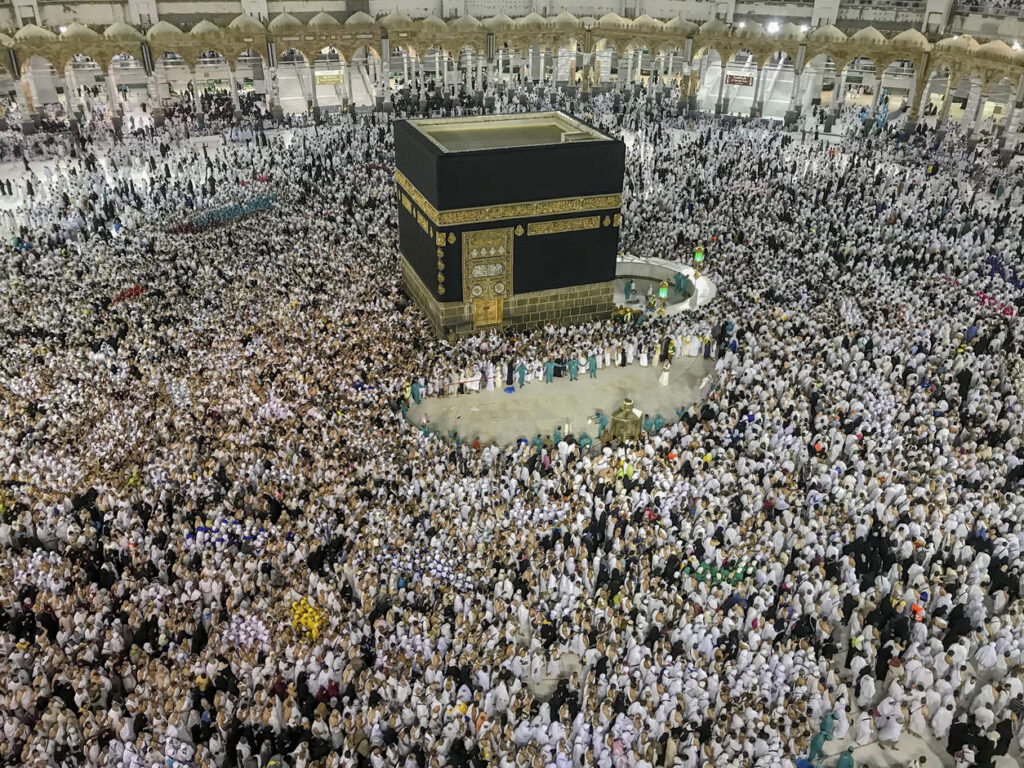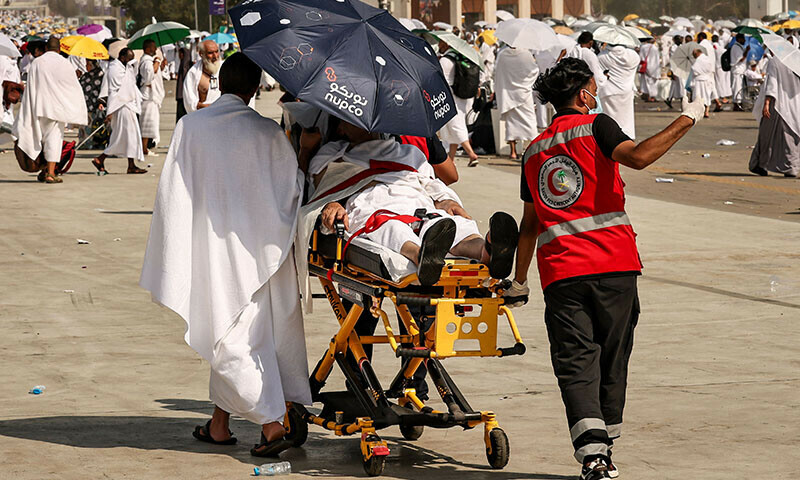
Credit Dar Yasin/Associated Press
More than 1,000 pilgrims have died during Hajj this week. Nearly half of the pilgrims who started the journey last Friday are unregistered. Overcrowding and extreme heat are the main reasons behind the rising number of deaths
Nearly 2 million Muslims completed the Hajj pilgrimage this week.
However, extreme heat has proved deadly for thousands who began the journey to the Kaaba in Mecca, Saudi Arabia last Friday.
Almost 1,000 pilgrims have died during the Hajj this year, according to AFP. About half of them are unregistered.
Thousands are also being treated for heatstroke as temperatures in Mecca reached 49 degrees Celsius (120 degrees Fahrenheit).
Crowds in Mecca
To perform the Hajj, pilgrims must obtain official permission from Saudi Arabia. Saudi Arabia enforces an annual quota system because the number of Muslims wishing to immigrate far exceeds the space available.
According to the Indian Express, overcrowding and overheating have been major issues in the past.
More than half of the 1,000 pilgrims who died were unregistered.
An Arab ambassador said about 658 Egyptian pilgrims were killed.

Muslim pilgrims gather at the top of the rocky hill known as the Mount of Mercy on the Plain of Arafat during the annual Hajj pilgrimage, near the holy city of Mecca, Saudi Arabia, Saturday, June 15, 2024. AP
Muslim pilgrims gather at the top of the rocky hill known as the Mount of Mercy in the Plain of Arafat, near the holy city of Mecca, Saudi Arabia, Saturday, June 15, 2024, during the annual Hajj pilgrimage.
Of these, 630 were pilgrims who had not registered.
According to AFP sources, about 90 of the dead were Indians.
Pilgrims from Senegal, Tunisia, Indonesia, Iran, Jordan and Senegal have also been reported dead.
Several pilgrims are also reported missing; photos of the missing and calls for information have flooded Facebook and other social media platforms.
An Egyptian man at Mecca’s medical complex on Wednesday broke down when he heard that his mother was among the dead. He cried for a while and then picked up his cellphone and called his travel agent, according to the Associated Press.
“He left him to die,” she shouted, referring to the agent. The crowd tried to pacify her.
Security was tight at the compound, with an officer reading out the names and nationalities of the dead, who included people from Algeria, Egypt and India.
People who said they were relatives of the deceased were allowed inside to identify the deceased.
Extreme heat makes the situation worse
This year’s death toll suggests something else is driving the rise in fatalities.
According to the report, several countries have already said that extreme heat at the holy site of Mecca has caused the deaths of some of their pilgrims, including Jordan and Tunisia.
Indian pilgrim Khalid Bashir Bajaj, speaking near the Grand Mosque on Wednesday, said that during this year’s hajj he had seen “many people fainting and falling to the ground.”
Muslim pilgrims use umbrellas to shield themselves from the sun as they arrive to throw stones at pillars to symbolically stone the devil as the final rite of the annual hajj, in Mina, near the holy city of Mecca, Saudi Arabia, Tuesday, June 18, 2024.
Temperatures in Mecca and holy sites around the city reached 47 degrees Celsius (117 degrees Fahrenheit) on Tuesday, according to the Saudi National Center for Meteorology.
Some people fainted while trying to symbolically stone the devil.
Many Egyptians said they forgot their loved ones in the heat and crowds.
Heat-related deaths during the hajj have been recorded since the 1400s. Pilgrims’ weakness is due to fatigue, open defecation and advanced age, as well as inability to acclimatize to the heat. Last year, more than 2,000 people suffered from heat stress during that hajj, according to Saudi officials.
Climate change may increase this danger even further.
According to Reuters, a 2021 study in the journal Environmental Research Letters found that if global temperatures rise by 2.7 degrees Fahrenheit above pre-industrial levels, the risk of heat stroke for Hajj pilgrims will increase fivefold.
A 2019 study by experts at the Massachusetts Institute of Technology found that even if the world succeeds in mitigating the worst effects of climate change, the Hajj will be held in temperatures above the “extreme danger threshold” from 2047 to 2052 and from 2079 to 2086.
Climate scientist Fahad Saeed says these deaths indicate future risks for millions of Hajj pilgrims.
“We need to prepare, we need to adapt, and we need to offer as many adaptation options as possible. Realising that this will affect a centuries-old ritual, we still need to protect people. But at the same time, we must take climate action to limit global warming to 1.5 degrees centigrade. Any higher than that, we are putting those pilgrims at risk of death.” Saudi Arabia has spent billions of dollars on crowd control and security measures for those taking part in the annual five-day pilgrimage, but the sheer number of participants makes it difficult to ensure their safety. In 2016, Saudi Arabia implemented a heat strategy with shaded areas, water points every 500 metres and improved healthcare.
Deaths during Hajj

Credit image india.shafaqna.com
The timing of the hajj is based on the lunar year, which shifts back 10 days each year.
Although the hajj is now moving to winter, by the 2040s it will be at the peak of summer in Saudi Arabia.
More than 1.83 million Muslims will perform the hajj in 2024, including more than 1.6 million from 22 countries and about 222,000 Saudi citizens and residents, according to Saudi hajj officials.
Deaths are not uncommon on the hajj.
Stampedes and epidemics have also occurred throughout the pilgrimage’s history.
More than 2,400 pilgrims were killed in a stampede in Mina in 2015 during the hajj, the deadliest incident ever on the pilgrimage, according to AP calculations.
Saudi Arabia has never acknowledged the full number of people killed in stampedes.
A separate crane collapse at Mecca’s Grand Mosque killed 111 people the same year as the Mina disaster. The second-deadliest incident at the Hajj was a stampede in 1990 that killed 1,426 people. The Hajj draws millions of pilgrims from low-income countries each year, “many of whom have received little or no healthcare prior to the Hajj,” according to an article published in the April edition of the Journal of Infection and Public Health. It says infectious diseases can spread among the gathered people, many of whom save their entire lives for the pilgrimage and may be elderly people with pre-existing health problems. Still, pilgrims are determined — for some, it’s a once-in-a-lifetime event. “Hajj is the fifth pillar of Islam and it is a mandatory duty for every able-bodied person. So you have to make efforts and get tired. Hajj is a difficult task, so you have to make efforts and perform the rituals even in hot and crowded conditions. You use umbrellas, drink water and pour it on your body to avoid dehydration. And sprinkling water in the walkway also helps.”




